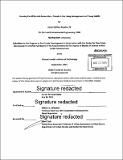| dc.contributor.advisor | William C. Wheaton. | en_US |
| dc.contributor.author | Roache, David William | en_US |
| dc.contributor.other | Massachusetts Institute of Technology. Center for Real Estate. Program in Real Estate Development. | en_US |
| dc.date.accessioned | 2016-02-29T14:59:52Z | |
| dc.date.available | 2016-02-29T14:59:52Z | |
| dc.date.copyright | 2015 | en_US |
| dc.date.issued | 2015 | en_US |
| dc.identifier.uri | http://hdl.handle.net/1721.1/101321 | |
| dc.description | Thesis: S.M. in Real Estate Development, Massachusetts Institute of Technology, Program in Real Estate Development in conjunction with the Center for Real Estate, 2015. | en_US |
| dc.description | Cataloged from PDF version of thesis. | en_US |
| dc.description | Includes bibliographical references (page 48). | en_US |
| dc.description.abstract | The current generation of young adults dubbed the "Millennials" are far different from past generations in many ways. They prefer renting to owning, shun the suburbs for cities, are likely to live at home with their parents, are putting off marriage and they are well educated. This thesis seeks to study how the living arrangements of the Millennial generation compare to those of the past generations to find out how true this conventional wisdom is. It studies U.S. Census Data from past decades, focusing on the population segment between ages 22 and 31 at each decennial census from 1980-2010. The demographic characteristics of age, marriage and education are studied to determine their influence on the living arrangements of this young adult cohort. Using linear regression models, the propensity to live in different forms of tenure or within a center city of and MSA are parsed out to find what portion of this propensity is due to the delay of marriage, increase in education or changes in the young adult population. The study is then further broken down to determine to what extent changes in living arrangements are due to changes in the preferences of the population versus changes in the demographic composition of the population. From 1980-2010 there has been a decline in the marriage rate and homeownership rate of the population, markedly so amongst young adults. Conversely, there has been an increase in those completing four years of college and the rate of the population living in a home where their parent is the head of household. This study shows that the decline in marriage has reduced the homeownership rate, but there is an increased preference for homeownership amongst those never married especially so amongst young adults. In general there has been a large increase in the preference of young adults to live at home and a decline in the preference to own or rent indicating that those not buying are opting to move in with their parents rather than rent. There has not been an increase amongst Millennials in preference or total propensity to live in center cities. | en_US |
| dc.description.statementofresponsibility | by David William Roache. | en_US |
| dc.format.extent | 78 pages | en_US |
| dc.language.iso | eng | en_US |
| dc.publisher | Massachusetts Institute of Technology | en_US |
| dc.rights | M.I.T. theses are protected by copyright. They may be viewed from this source for any purpose, but reproduction or distribution in any format is prohibited without written permission. See provided URL for inquiries about permission. | en_US |
| dc.rights.uri | http://dspace.mit.edu/handle/1721.1/7582 | en_US |
| dc.subject | Center for Real Estate. Program in Real Estate Development. | en_US |
| dc.title | Housing the millennial generation : trends in the living arrangements of young adults | en_US |
| dc.type | Thesis | en_US |
| dc.description.degree | S.M. in Real Estate Development | en_US |
| dc.contributor.department | Massachusetts Institute of Technology. Center for Real Estate. Program in Real Estate Development. | en_US |
| dc.contributor.department | Massachusetts Institute of Technology. Center for Real Estate | |
| dc.identifier.oclc | 938685892 | en_US |
